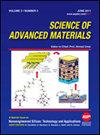Effects of Callicarpa nudiflora Granules on the Proliferation and Apoptosis of Uterine Fibroid Cells
IF 0.9
4区 材料科学
引用次数: 0
Abstract
This research was aimed to discuss and understand the effects and mechanisms of action of Callicarpa nudiflora granules on proliferation and apoptosis of uterine leiomyoma (UL) cells. Firstly, normal uterine myometrium (UM) and UL tissues were collected, and the levels of p-Akt and Phosphatase and Tensin Homolog (PTEN) in UL tissues were detected using immunohistochemistry. Next, the UL cells were successfully obtained using enzymatic digestion, and their identification was performed using alpha-smooth muscle actin ( α -actin) immunocytochemistry. Specifically, the cells were grouped into four: a control group (CG), a low-dose group (LDG, 50 mg/L Callicarpa nudiflora solution), a medium-dose group (MDG, 100 mg/L Callicarpa nudiflora solution), and a high-dose group (HDG, 200 mg/L Callicarpa nudiflora solution). Moreover, the proliferation of UL cells was assessed using the thiazolyl blue (MTT) assay, while cell apoptosis was analyzed using flow cytometry (FCT). Real-time fluorescent quantitative PCR (fq-PCR) and Western blot assay (WBA) were utilized to determine the PAI-1, P38, TGF- β 1, E-cadherin, and Vimentin in UL cells. The results revealed that the positive rate (PR) of p-Akt in the UL tissues was much higher to that in normal UM tissues ( P < 0.001). More than 90% of UL cells were positive for α -actin. The viabilities of UL cells in the Callicarpa nudiflora treatment groups were greatly weakened to that of untreated cells ( P < 0.05). Viability of UL cells in the HDG group was the lowest, showing a great difference with P < 0.01 to the LDG group and that with P < 0.05 to the MDG group, while that between the MDG and LDG groups exhibited a great difference with P < 0.05. AR of UL cells in CG group was sharply lower to that in the Callicarpa nudiflora treatment groups, showing great differences with P < 0.05, P < 0.01, and P < 0.001, respectively. AR of UL cells in HDG group was higher to the LDG group ( P < 0.01) and MDG group ( P < 0.05), and that in LDG group was lower and exhibited a great difference with P < 0.05 to the MDG group. The HDG, LDG, and MDG groups exhibited greatly lower TGF- β 1, PAI-1, and P38 to the CG group ( P < 0.05). In the HDG group, the TGF- β 1, PAI-1, P38, and Vimentin levels were greatly lower and presented a great difference with P < 0.01 to those in the CG group and LDG group. Additionally, E-cadherin in UL cells was elevated in the LDG and MDG groups to CG group, showing P < 0.05 and P < 0.01, respectively. Such findings indicated that the Callicarpa nudiflora granules can suppress proliferation of UL cells and promote their apoptosis, which may be associated with the TGF- β 1/P38/PAI-1 singling pathway (SPW).海棠花颗粒对子宫肌瘤细胞增殖和凋亡的影响
本研究旨在探讨和了解海参颗粒对子宫平滑肌瘤(UL)细胞增殖和凋亡的影响及其作用机制。首先采集正常子宫肌层(UM)和子宫内膜(UL)组织,采用免疫组化方法检测UL组织中p-Akt、磷酸酶和张力素同源物(PTEN)的水平。接下来,通过酶切成功获得UL细胞,并使用α -平滑肌肌动蛋白(α -actin)免疫细胞化学对其进行鉴定。将细胞分为4组:对照组(CG)、低剂量组(LDG, 50 mg/L海参草溶液)、中剂量组(MDG, 100 mg/L海参草溶液)和高剂量组(HDG, 200 mg/L海参草溶液)。此外,使用噻唑蓝(MTT)法评估UL细胞的增殖,使用流式细胞术(FCT)分析细胞凋亡。采用实时荧光定量PCR (fq-PCR)和Western blot法(WBA)检测UL细胞中PAI-1、P38、TGF- β 1、E-cadherin和Vimentin的表达。结果显示,P - akt在UL组织中的阳性率(PR)明显高于正常UM组织(P <0.001)。90%以上的UL细胞α -actin阳性。与未处理的细胞相比,海棠花处理组的UL细胞活力明显减弱(P <0.05)。HDG组UL细胞活力最低,与P、lt组差异显著;LDG组与P <组的差异为0.01;MDG组与LDG组P < 0.05, MDG组与LDG组P < 0.05差异显著;0.05. CG组UL细胞的AR明显低于海棠花处理组,与P <差异显著;0.05, P <0.01, P <0.001,分别。HDG组UL细胞的AR明显高于LDG组(P <0.01)和MDG组(P <0.05), LDG组较低,且与P <组差异显著;千年发展目标组为0.05。HDG、LDG和MDG组TGF- β 1、PAI-1和P38明显低于CG组(P <0.05)。HDG组TGF- β 1、PAI-1、P38、Vimentin水平明显降低,与P <差异显著;与CG组、LDG组比较为0.01。LDG和MDG组与CG组相比,UL细胞E-cadherin升高,P <0.05和P <0.01,分别。上述结果提示,海棠颗粒具有抑制UL细胞增殖、促进其凋亡的作用,其作用机制可能与TGF- β 1/P38/PAI-1单链通路(SPW)有关。
本文章由计算机程序翻译,如有差异,请以英文原文为准。
求助全文
约1分钟内获得全文
求助全文
来源期刊

Science of Advanced Materials
NANOSCIENCE & NANOTECHNOLOGY-MATERIALS SCIENCE, MULTIDISCIPLINARY
自引率
11.10%
发文量
98
审稿时长
4.4 months
 求助内容:
求助内容: 应助结果提醒方式:
应助结果提醒方式:


